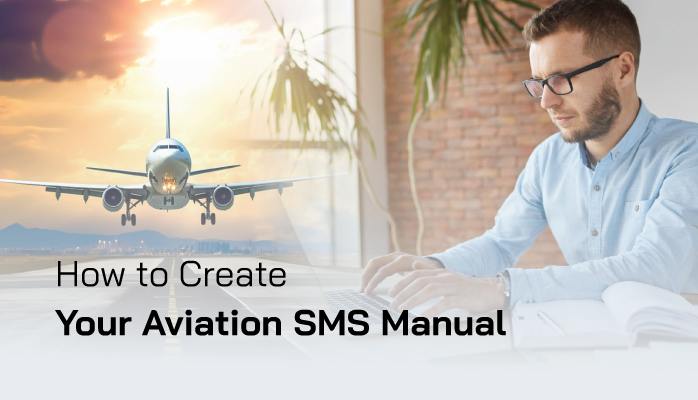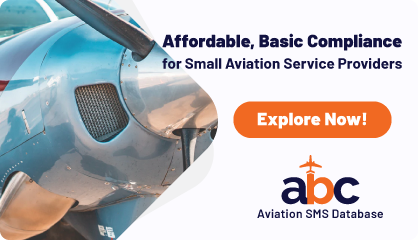Why Create an Aviation SMS Manual?

In aviation, where safety is paramount, a Safety Management System (SMS) is the foundation for managing risks and ensuring operational excellence.
At the core of any SMS lies the SMS manual—a critical document that outlines an organization’s safety policies, procedures, and processes. For aviation safety managers, crafting a comprehensive SMS manual is essential for meeting regulatory requirements, passing audits, and fostering a culture where safety is everyone’s priority.
This guide offers a globally applicable approach to creating an effective aviation SMS manual, tailored for safety managers across diverse contexts—from bustling international hubs to remote regions like Alaska.
Why an SMS Manual Matters
An SMS manual is more than a regulatory checkbox; it’s a strategic tool that drives safety performance. It serves multiple purposes:
-
Regulatory Compliance: Meets standards set by the International Civil Aviation Organization (ICAO) and regional authorities like the FAA and EASA.
-
Audit Readiness: Provides auditors with clear evidence of safety processes and compliance.
-
Operational Clarity: Guides staff on safety responsibilities and procedures.
-
Cultural Foundation: Reinforces a just culture where hazard reporting is encouraged.
-
Training Resource: Educates employees on SMS principles and their roles.
Without a well-crafted manual, organizations risk non-compliance, safety gaps, and inefficiencies. For aviation safety managers, the manual is a roadmap to safer operations, ensuring consistency and accountability across all levels.
Related Aviation SMS Manual Articles
- 3 Best Practices for Your Aviation SMS Manual
- Tips Writing SMS Manuals With Aviation Safety Database Solutions
- Best Practices Reviewing Aviation SMS Manuals
Regulatory Framework for SMS Manuals
Global and regional standards provide the foundation for SMS manuals:
-
ICAO Annex 19: Mandates SMS implementation, requiring a documented manual that covers all safety-critical processes (ICAO Annex 19).
-
FAA Advisory Circular 120-92B: Offers guidance for U.S. operators, emphasizing documentation of SMS components (FAA AC 120-92B).
-
EASA Regulations: Require detailed SMS documentation, particularly for airworthiness and operations (EASA Regulations).
-
Universal Standard: Across jurisdictions, regulators expect a manual that reflects actual safety practices, tailored to the organization’s size and complexity.
These frameworks ensure that SMS manuals are globally consistent yet adaptable to local needs and operational procedures, such as Alaska’s unique operational challenges.
Key Components of an Aviation SMS Manual
An effective SMS manual should align with the four pillars of SMS as outlined in ICAO Document 9859: Safety Policy, Safety Risk Management, Safety Assurance, and Safety Promotion. Each pillar requires specific elements to ensure comprehensive coverage.
1. Safety Policy
-
Statement of Commitment: A signed declaration from the accountable executive affirming the organization’s dedication to safety.
-
Safety Objectives: Specific, measurable goals, such as reducing incident rates by a defined percentage or increasing hazard reports.
-
Roles and Responsibilities: Clearly defined duties for all staff, including the safety manager and accountable executive, ensuring everyone understands their part in safety.
Related Aviation SMS Safety Policy Articles
- The Five Elements of ICAO's Safety Policy and Objectives in SMS
- How to Promote Your Aviation SMS Safety Policy
- 4 Critical Elements in Your Aviation SMS' Safety Policy Component
2. Safety Risk Management
-
Hazard Identification: Processes for proactively identifying hazards (e.g., safety assessments) and reactively collecting data (e.g., incident reports).
-
Risk Assessment: Methods for evaluating risks, such as risk matrices assessing severity and likelihood.
-
Risk Mitigation: Strategies for controlling risks, including implementation plans, monitoring, and feedback loops to staff.
Related Aviation Risk Management Process Articles
- What Is the Process of Risk Management in Aviation SMS
- What Are Important Factors of Aviation Risk Management Process
- How to Optimize Risk Management Processes for Aviation SMS
3. Safety Assurance
-
Safety Performance Monitoring: Systems for tracking safety performance indicators, like incident rates or audit findings.
-
Safety Reviews and Audits: Procedures for conducting internal audits and reviews to ensure SMS effectiveness.
-
Corrective Actions: Processes for addressing safety deficiencies and preventing recurrence, with clear documentation.
Related Aviation SMS Safety Assurance Articles
- 4 Pillars | What Safety Assurance Really Means in Aviation SMS
- Best Tip for Safety Assurance Monitoring in Aviation SMS
- FAA Part 5 Compliance | Safety Assurance Performance Monitoring and Data Acquisition Components
4. Safety Promotion
-
Training and Education: Programs to ensure all employees are competent in SMS principles and their roles.
-
Communication: Channels for sharing safety information, such as safety bulletins or hazard reporting systems.
-
Just Culture: Policies promoting a non-punitive environment to encourage open reporting of safety concerns.
Related Aviation Safety Promotion Articles
- 4 Pillars | What Is Safety Promotion Component (the "Overlooked" Pillar)
- Why Safety Promotion Requires More Focus in Aviation SMS
- Safety Chart: Stay on Top of Aviation Safety Promotion With SMS Newsletters
Additional SMS manual elements include:
-
Regulatory References: List applicable standards and exemptions.
-
Emergency Response Plans: Tailored to each location, addressing local risks like extreme weather in Alaska.
-
Vendor Coordination: Describe how external providers are integrated into SMS processes.
The manual should be concise, with detailed procedures cross-referenced in other documents to keep it user-friendly, as recommended by Air Safety Support International.
Best Practices for Crafting an SMS Manual
Creating an effective SMS manual requires strategic planning and attention to detail. Here are timeless best practices to ensure your manual is impactful and audit-ready:
1. Start with Existing Processes
-
Document current safety policies and procedures as a foundation. Use gap analysis to identify areas needing enhancement, aligning with ICAO standards.
-
Include placeholders for future processes to build a scalable manual.
2. Follow Established Guidance
-
Use ICAO Document 9859 for a standardized structure, which includes 15 sections with predefined subheadings.
-
For U.S. operators, incorporate guidance from FAA Advisory Circular 120-92B.
3. Keep It Simple and Clear
-
Write in straightforward language, avoiding jargon to ensure accessibility for all employees.
-
Use headings, subheadings, bullet points, and white space for readability.
-
For digital manuals, enable search functionality to navigate complex content.
4. Ensure Accessibility
-
Store the manual digitally for anytime, anywhere access, avoiding physical copies in inaccessible locations.
-
Ensure all staff, from pilots to ground crew, can easily reference the manual.
5. Tailor to Your Organization
-
For small operators, create a concise manual referencing existing policies. Larger organizations may need detailed documentation for each department.
-
Address regional risks, such as Alaska’s extreme weather or remote operations, with specific procedures like cold-weather fueling protocols.
6. Update Regularly
-
Schedule annual reviews or updates after significant operational or regulatory changes.
-
Digital formats simplify revisions, ensuring the manual remains relevant.
7. Engage Stakeholders
-
Involve employees from all levels in development and review to ensure the manual reflects real operations and fosters buy-in.
-
Use feedback to refine processes and improve clarity.
8. Align with Other Documents
-
Ensure consistency with quality manuals or operational procedures to avoid duplication and streamline processes.
|
Best Practice |
Description |
Benefit |
|---|---|---|
|
Start with Existing Processes |
Document current policies and use gap analysis |
Builds on established practices |
|
Follow ICAO Guidance |
Use Doc 9859 for structure |
Ensures regulatory compliance |
|
Keep It Simple |
Use clear language and formatting |
Enhances readability |
|
Ensure Accessibility |
Store digitally |
Improves staff access |
|
Tailor to Context |
Address organizational and regional needs |
Increases relevance |
|
Update Regularly |
Review annually or as needed |
Maintains accuracy |
|
Engage Stakeholders |
Involve all staff levels |
Reflects real operations |
|
Align with Documents |
Coordinate with other manuals |
Avoids duplication |
Tailoring the SMS Manual to Your Organization
While SMS manuals must meet universal standards, they should reflect your organization’s unique context:
-
Size and Complexity: Small operators, like regional Alaskan carriers, may use a streamlined manual, while large airlines need detailed documentation for multiple departments.
-
Operational Environment: In remote regions, include procedures for extreme weather, remote operations, or limited infrastructure. In high-traffic hubs, focus on vendor coordination and complex operations.
-
Cultural Fit: Use language and examples that resonate with your workforce, addressing cultural diversity or language barriers in global teams.
-
Vendor Integration: Detail how external providers, like maintenance or fueling vendors, are incorporated into SMS processes, including hazard reporting and audits.
For example, an Alaskan operator might include specific protocols for de-icing aircraft or managing fuel in subzero temperatures, while a hub airport might emphasize multi-vendor safety coordination.
Related Articles on Vendors/Suppliers in Aviation SMS
- Performing Vendor Safety Assessments for Aviation SMS
- Why Include Vendors in Aviation Safety Management Systems (SMS)?
- Auditing Vendors/Suppliers in Aviation Safety Management Systems (SMS)
Supporting SMS with Training and Culture
An SMS manual is only effective if supported by robust training and a strong safety culture:
-
Comprehensive Training: Develop programs covering SMS principles, roles, and responsibilities. Include initial training for new hires and recurrent training for all staff, tailored to local risks (e.g., Alaska’s weather challenges).
-
Just Culture: Foster a non-punitive environment where employees feel safe reporting hazards. This encourages proactive safety management.
-
Leadership Commitment: Senior management should actively participate in safety initiatives, attending meetings and allocating resources to demonstrate SMS priority.
The manual serves as a reference for training and a foundation for safety cultural initiatives, ensuring all staff understand and engage with safety processes.
Real-World Examples
Example 1: Small Alaskan Operator
A regional Alaskan carrier developed a concise SMS manual tailored to its remote operations. It included specific procedures for cold-weather fueling and emergency response in isolated areas, using SMS Pro's version-controlled documentation storage for accessibility. Regular staff training on these protocols ensured audit success, demonstrating compliance with FAA standards.
Example 2: International Hub Airline
A large airline in a major hub created a detailed SMS manual with comprehensive vendor coordination sections. By aligning with ICAO Doc 9859 and engaging staff in development, the airline passed both IATA and EASA audits and reduced ground handling incidents.
Example 3: Emerging Market Operator
An operator in Southeast Asia used SMS Pro's included SMS manual template to structure its manual, focusing on simplified language for a diverse workforce. Regular updates and training ensured compliance with growing regulatory demands, enhancing safety performance.
Resources for Creating Your SMS Manual
-
ICAO Safety Management Manual (Doc 9859): Comprehensive guidance on SMS structure and content.
-
FAA Advisory Circular 120-92B: Practical advice for U.S. operators.
-
NBAA/IBAC SMS Toolkit: A tool for implementing SMS in business aviation.
-
IS-BAO: A scalable SMS framework for benchmarking (IS-BAO).
- SMS Pro Template: Included with every SMS Pro subscription, best suited for mid-to-large-size operators.
Conclusion: Building a Foundation for Safer Skies
Creating an effective aviation SMS manual is a critical step toward ensuring safety, compliance, and operational excellence. By documenting the four SMS pillars, following best practices, and tailoring the manual to your organization’s needs, you can develop a document that not only meets regulatory standards but also drives a robust safety culture.
Regular updates, staff engagement, and a commitment to just culture ensure the manual remains a living tool for safety management. Whether navigating remote operational challenges or managing a global hub, a well-crafted SMS manual is your guide to safer skies, empowering aviation safety managers to lead with confidence.
A very nice SMS manual template is included in every SMS Pro subscription. This template is often worth the subscription price as it negates the need for an external consultant.
Last updated in May 2025.









